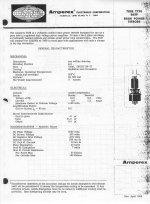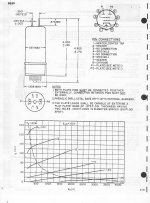I boosted the heaters on a 33" CRT some 20 years ago when it was to dim for daytime viewing. It restored full brightness and is still going strong as the spare room TV.
Well, that's an interesting idea. aka: The old CRT tube rejuvenators.
If you can't lower the heater voltage originally to extend tube life, then boost it later instead, as the cathode starts to fail.
-----------------
Having come upon a few 12HL7 video amp tubes for cheap recently, I have been trying to come up with ratings appropriate for use as output tubes. (and obviously shorter life) The datasheet does not give a DC max current or peak current ratings. From the plate curves given (for video), one can estimate DC average as about 1/2 the max plate current shown, or 50 to 60 mA. But output tubes push the ratings. So I measured the active cathode area (one side) for some various tubes to compare with their DC current ratings and heater power.
Video: 12HL7: 4mm x 15.75 mm = 63 mm^2, HTR: 6.3V x 0.6 Amp
Vertical: 6HB6: 3.25mm x 24mm = 78 mm^2, HTR: 6.3V x 0.76 Amp
Audio/Video: 6BQ5/6GK6: 3.25 mm x 24 mm = 78 mm^2, HTR: 6.3V x 0.76 Amp, Rated 65 mA DC
TV Sweep Output Tubes:
6JN6/6GE5: 4.4mm x 25mm = 110 mm^2, HTR: 6.3V x 1.2 Amp, Rated 175 mA DC, 550 mA Peak
6HB5: 5mm x 29 mm = 145 mm^2, HTR: 6.3V x 1.5 Amp, Rated 230 mA DC, 800 mA Peak
6LR6: 6.75mm x 33.25mm = 224 mm^2, HTR: 6.3V x 2.5 Amp, Rated 375 mA DC, 1300 mA Peak
6MC6/6LX6: 6.8mm x 40.5mm = 275.4 mm^2, HTR: 6.3V x 2.85/2.55 Amp, Rated 400 mA DC, 1400 mA Peak
For the rated 6BQ5/6GK6:
Rated DC mA per mm^2 = 0.83
and Rated DC mA per HTR Amps (at 6.3V) = 85.5
And for the Sweep tubes:
average Rated DC mA per mm^2 = 1.58
and average Rated DC mA per HTR Amps (at 6.3V) 149
So rating the 12HL7 by the 6BQ5/6GK6 would give: 52.5 mA max DC (by area) and 51.3 mA max DC (by HTR)
and rating the 12HL7 by the TV Sweeps would give: 99.5 mA max DC (by area) and 89.4 mA max DC (by HTR)
(and then Peak mA rating is typically 3.2 to 3.5 x max DC mA rating)
The Sweep tubes are obviously rated more liberally than small signal tubes.
( and likely don't last as long. )
By the way, I think I would call the 12HL7 a 7.5 Watt P_diss tube for Video use (by its plate size), and maybe, give it the full datasheet 10 Watt rating for output duty.
So it sure looks like signal type tubes could have their heater voltage reduced and still meet current emission requirements. (the datasheets usually show 10% HTR V reduction within the acceptable range, but 20% may be possible) (emission being exponential with V, a 20% HTR V reduction would correspond to the 90 mA to 51 mA ratio seen above for rating the 12HL7, ie, the 12HL7 would still be able to put out the 51 mA DC with a 20% HTR V reduction. OTOH, looks like the Sweeps have no room to spare for HTR V reduction. )
(Well, the TV Sweep datasheets generally show an allowance for 10% HTR V reduction, so maybe there is still some squiggle room. V HTR better be regulated.)
---
If you can't lower the heater voltage originally to extend tube life, then boost it later instead, as the cathode starts to fail.
-----------------
Having come upon a few 12HL7 video amp tubes for cheap recently, I have been trying to come up with ratings appropriate for use as output tubes. (and obviously shorter life) The datasheet does not give a DC max current or peak current ratings. From the plate curves given (for video), one can estimate DC average as about 1/2 the max plate current shown, or 50 to 60 mA. But output tubes push the ratings. So I measured the active cathode area (one side) for some various tubes to compare with their DC current ratings and heater power.
Video: 12HL7: 4mm x 15.75 mm = 63 mm^2, HTR: 6.3V x 0.6 Amp
Vertical: 6HB6: 3.25mm x 24mm = 78 mm^2, HTR: 6.3V x 0.76 Amp
Audio/Video: 6BQ5/6GK6: 3.25 mm x 24 mm = 78 mm^2, HTR: 6.3V x 0.76 Amp, Rated 65 mA DC
TV Sweep Output Tubes:
6JN6/6GE5: 4.4mm x 25mm = 110 mm^2, HTR: 6.3V x 1.2 Amp, Rated 175 mA DC, 550 mA Peak
6HB5: 5mm x 29 mm = 145 mm^2, HTR: 6.3V x 1.5 Amp, Rated 230 mA DC, 800 mA Peak
6LR6: 6.75mm x 33.25mm = 224 mm^2, HTR: 6.3V x 2.5 Amp, Rated 375 mA DC, 1300 mA Peak
6MC6/6LX6: 6.8mm x 40.5mm = 275.4 mm^2, HTR: 6.3V x 2.85/2.55 Amp, Rated 400 mA DC, 1400 mA Peak
For the rated 6BQ5/6GK6:
Rated DC mA per mm^2 = 0.83
and Rated DC mA per HTR Amps (at 6.3V) = 85.5
And for the Sweep tubes:
average Rated DC mA per mm^2 = 1.58
and average Rated DC mA per HTR Amps (at 6.3V) 149
So rating the 12HL7 by the 6BQ5/6GK6 would give: 52.5 mA max DC (by area) and 51.3 mA max DC (by HTR)
and rating the 12HL7 by the TV Sweeps would give: 99.5 mA max DC (by area) and 89.4 mA max DC (by HTR)
(and then Peak mA rating is typically 3.2 to 3.5 x max DC mA rating)
The Sweep tubes are obviously rated more liberally than small signal tubes.
( and likely don't last as long. )
By the way, I think I would call the 12HL7 a 7.5 Watt P_diss tube for Video use (by its plate size), and maybe, give it the full datasheet 10 Watt rating for output duty.
So it sure looks like signal type tubes could have their heater voltage reduced and still meet current emission requirements. (the datasheets usually show 10% HTR V reduction within the acceptable range, but 20% may be possible) (emission being exponential with V, a 20% HTR V reduction would correspond to the 90 mA to 51 mA ratio seen above for rating the 12HL7, ie, the 12HL7 would still be able to put out the 51 mA DC with a 20% HTR V reduction. OTOH, looks like the Sweeps have no room to spare for HTR V reduction. )
(Well, the TV Sweep datasheets generally show an allowance for 10% HTR V reduction, so maybe there is still some squiggle room. V HTR better be regulated.)
---
Last edited:
Well, here are some HV oxide cathode tube oddities.
Against the tube laws!
6BU5 a 20,000 V pentode with a coated unipotential cathode. Presumably oxide, or maybe something special?
https://frank.pocnet.net/sheets/127/6/6BU5.pdf
8068 3500V pentode
https://frank.pocnet.net/sheets/142/8/8068.pdf
7403 4000V pentode
https://frank.pocnet.net/sheets/131/7/7403.pdf
8639 4000V pentode:
and then there were the HV beam triodes: 6LH6, 6LJ6, 6JK5, 6HS5, 6JH5, 6JD5, 6HZ5, 6HV5
Against the tube laws!
6BU5 a 20,000 V pentode with a coated unipotential cathode. Presumably oxide, or maybe something special?
https://frank.pocnet.net/sheets/127/6/6BU5.pdf
8068 3500V pentode
https://frank.pocnet.net/sheets/142/8/8068.pdf
7403 4000V pentode
https://frank.pocnet.net/sheets/131/7/7403.pdf
8639 4000V pentode:
and then there were the HV beam triodes: 6LH6, 6LJ6, 6JK5, 6HS5, 6JH5, 6JD5, 6HZ5, 6HV5
Attachments
Last edited:
Well, here are some HV oxide cathode tube oddities.
Against the tube laws!
I once came across a huge junk tube that I was going to hook up the heater to a bench supply and watch it glow. Can't remember the type but it was a big triode meant for pulsing a magnetron. I believe it was good up to 35kV and had an oxide coated cathode. The heater ran at 6.3V @ 60A (300A surge for several seconds at startup). Wish I could remember the type. I remember it was made by Machlett.
Edit: Found it. ML-7003. 45kV, oxide-coated unipotential cathode. 3kW plate.
Edit2: Needless to say, I gave up on lighting the tube up when I read the heater spec!
Last edited:
My reading of it from a few years back is that, manufacturing defects aside, cathode degradation is normally a very slow process. It speeds up toward end of life because emission from the cathode is never perfectly even and parts of the cathode are hotter and emit more than others. Hot parts increasing carry the current load and get locally hotter through R losses, so emit more so carry more load so get hotter etc etc until the cathode locally is damaged by runaway and an non emissive 'spot' forms. This is repeated and increasing %age of the cathode surface becomes non-emmisive, eventually reducing overall emission to the point where there isn't enough to meet spec.
This happens more in power valves because local R heating is far greater due to I being orders of magnitude greater and R heat being a function of I2. Thus signal valves show this far later in life, if at all.
So yes, keeping average Ik down in power valves can help life in principle.
Avoiding on/off cycles cathode heater when Ik is flowing can help too because it avoids the circumstance where only a small portion of the cathode is carrying the load for a short time as it heats up or cools down. Avoiding on/off cycles is good then, as can be B+ sequencing under some conditions in some valves.
Lowering the cathode temperature a little can help, by running slightly low heater current, because the headroom for hotspot formation is greater: the cathode can locally get hotter without damage. But lowering cathode temp too far can provoke uneven cathode heating, which is really the root of the problem, and can thus shorten life.
This explanation I believe fits most observations, and is based on vintage texts which I'd be hard pressed to recite now.
LD
This happens more in power valves because local R heating is far greater due to I being orders of magnitude greater and R heat being a function of I2. Thus signal valves show this far later in life, if at all.
So yes, keeping average Ik down in power valves can help life in principle.
Avoiding on/off cycles cathode heater when Ik is flowing can help too because it avoids the circumstance where only a small portion of the cathode is carrying the load for a short time as it heats up or cools down. Avoiding on/off cycles is good then, as can be B+ sequencing under some conditions in some valves.
Lowering the cathode temperature a little can help, by running slightly low heater current, because the headroom for hotspot formation is greater: the cathode can locally get hotter without damage. But lowering cathode temp too far can provoke uneven cathode heating, which is really the root of the problem, and can thus shorten life.
This explanation I believe fits most observations, and is based on vintage texts which I'd be hard pressed to recite now.
LD
- Status
- Not open for further replies.

